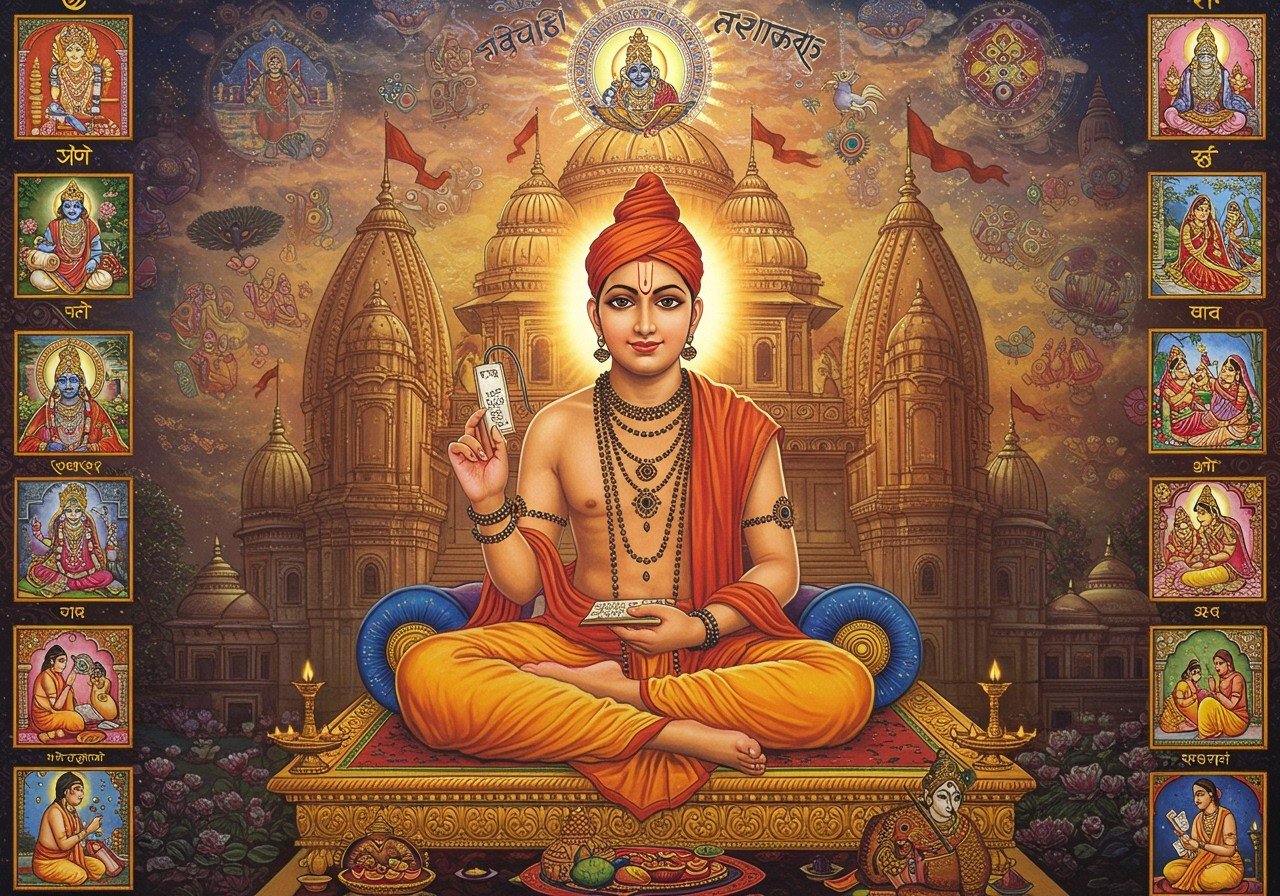Jiva Goswami: A Leading Light of Gaudiya Vaishnavism

Jiva Goswami (c. 1513 – c. 1598) holds a revered position in the spiritual lineage of Gaudiya Vaishnavism. As one of the six Goswamis of Vrindavan, he played a pivotal role in systematizing the teachings of Chaitanya Mahaprabhu (1486–1534). This article explores Jiva Goswami’s significant contributions, his philosophical insights, and his enduring legacy on this devotional movement.
Jiva Goswami’s Profound Philosophical Insights
Jiva Goswami is celebrated for his scholarly works, most notably the Sat Sandarbhas, a six-part treatise delving into the depths of Gaudiya philosophy. His teachings revolve around the concept of Achintya Bheda Abheda, the inconceivable oneness and difference between the divine and individual souls. This doctrine emphasizes the simultaneous unity and distinction between God and the living beings, a cornerstone of Gaudiya Vaishnava thought.
Furthermore, Jiva Goswami elaborated on the importance of Bhakti, or devotional service, highlighting its significance not only as a means to spiritual realization but also as the ultimate goal itself. His focus on rasa, devotional emotions, enriched the understanding of spiritual experience within the tradition.
The Radha Damodar Temple: A Legacy of Devotion
In 1542, Jiva Goswami established the Radha Damodar Temple in Vrindavan. This sacred space became a vital center for Gaudiya Vaishnavism, serving as a hub for both worship and scholarly pursuits. Within its walls, he installed deities of Radha and Krishna, lovingly sculpted by his uncle, Rupa Goswami.
The temple’s significance extends beyond its function as a place of worship. It served as a sanctuary for spiritual education, where Jiva Goswami nurtured and instructed numerous disciples, disseminating the wisdom of Chaitanya Mahaprabhu. The temple also acts as a repository for Jiva Goswami’s literary treasures, safeguarding his invaluable philosophical contributions for generations to come.
Jiva Goswami’s Interaction with Other Prominent Figures
While historical documentation is limited, the possibility of interactions between Jiva Goswami and Mirabai, the Rajput princess revered for her intense devotion to Krishna, sparks curiosity. Mirabai’s poetic expressions of divine love resonate with the emotional depth emphasized in Gaudiya Vaishnavism. It is conceivable that their paths may have crossed in Vrindavan, leading to an enriching exchange of spiritual insights.
Such encounters, in an era where Bhakti flourished, would have contributed significantly to the development of the broader devotional landscape.
Jiva Goswami’s Influence on ISKCON
The teachings of Jiva Goswami continue to resonate within contemporary spiritual movements, particularly the International Society for Krishna Consciousness (ISKCON). Founded by A.C. Bhaktivedanta Swami Prabhupada, ISKCON draws significantly from Jiva Goswami’s writings, particularly the Sat Sandarbhas. His interpretations of Gaudiya Vaishnava theology form a cornerstone of ISKCON’s philosophical foundation.
Jiva Goswami’s emphasis on Bhakti as both the means and the end of spiritual practice aligns perfectly with ISKCON’s core principles. His legacy fosters a global community united in their devotion to Krishna.
Jiva Goswami’s Enduring Literary Contributions
Jiva Goswami’s literary output is vast and deeply influential. Beyond the celebrated Sat Sandarbhas, his works encompass diverse fields, including grammar, poetics, and theology. The Harinamamrita Vyakarana, a Sanskrit grammar infused with devotional elements, exemplifies his unique approach to scholarship.
His profound erudition established a tradition of scholarly inquiry within Gaudiya Vaishnavism. Each generation continues to glean fresh insights from his writings, enriching their spiritual understanding and deepening their connection with the divine.
A Complete Guide to Laddu Gopal
Honoring Jiva Goswami’s Teachings with Sacred Murtis from Poojn.in
Jiva Goswami’s profound influence on Gaudiya Vaishnavism underscores the importance of devotional worship of Radha and Krishna. At Poojn.in, we offer authentic Radha Krishna murtis that help devotees practice this sacred tradition. Our collection includes:
- 10″ Astadhatu Brass Radha Krishna Murti (₹4,001): This finely crafted 2.5 kg murti measures 21.5 x 10 x 25 cm and is made from pure pital brass/ashtadhatu. This gold-colored murti brings divine grace to your worship space. You can find similar sacred idols on our Holy Idols page.
- 9″ Astadhatu Brass Radha Krishna Murti (₹3,749): A slightly smaller option at 2 kg, measuring 15 x 7.3 x 15 cm, ideal for home temples and personal worship. Enhance your personal altar with this exquisite murti, available at Poojn.in.
Both murtis are crafted following traditional specifications and are perfect for daily worship in line with Gaudiya Vaishnava traditions. Each piece comes with quality assurance from Poojn, India’s trusted Dashakarma bhandar. Bulk pricing is available for temples and religious institutions. Contact us on WhatsApp at +91 3369029784 for wholesale inquiries.
Conclusion: Jiva Goswami’s Timeless Impact
Jiva Goswami’s contributions to Gaudiya Vaishnavism are profound and enduring. His establishment of the Radha Damodar Temple provided a sanctuary for devotion and scholarship, nurturing the spiritual development of countless individuals. His influence on modern movements like ISKCON demonstrates his lasting relevance. His literary legacy, especially the Sat Sandarbhas, continues to illuminate the path for spiritual seekers across generations.


